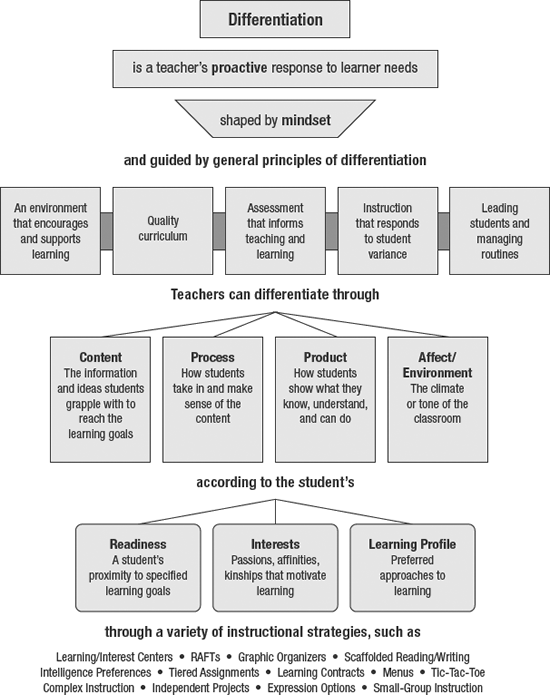e-Learning Ecologies MOOC’s Updates
Universal Design for Learning as an Authentic Pathway to Differentiated Instruction
In my exploration of differentiated instruction and learning, I have discovered the three key elements of universal design, a concept I explored in my week 2 post, naturally creates pathways for differentiated learning to occur in the classroom.
As an overview, universal design for learning (UDL) is defined as an “approach to curriculum that minimizes barriers and maximizes learning for all students” (CAST, 6 June 2010). Aligned with the concept of differentiated learning (which I will define momentarily), UDL posits each learner brings in a unique background, strength, needs, and interests, and proposes that learning “curriculum should provide genuine learning opportunities for each and every student” (CAST, 6 June 2010). UDL is focused on making sure the goals, methods, materials, and assessments of learning work for everyone. In an exploration of learning goals and barriers to achieve these goals, UDL promotes three principles to overcome barriers: Representation, Action and Expression, and Engagement. The key to these principles is in the practice of multiple; provide multiple representations of content in multiple media and supports, provide multiple means of action and expression while providing multiple opportunities for formative assessment and feedback, and provide multiple means of engagement with the content by giving students choices to “fuel their interest and autonomy” (CAST, 6 June 2010). The following video provides a strong overview of UDL:
ASCD (formerly known as the Association for Supervision and Curriculum Development) defines differentiated Instruction (DI) as “an approach to teaching in which educators actively plan for students' differences so that all students can best learn. In a differentiated classroom, teachers divide their time, resources, and efforts to effectively teach students who have various backgrounds, readiness and skill levels, and interests” (ASCD, n.d.). Noting the similarity to universal design for learning, Tomlinson and Moon (2013) provide a narrative overview of differentiated instruction in Chapter 1 of their text, Assessment and Student Success in a Differentiated Classroom, as well as the following concept map of differentiated applied to the classroom:
In regard to university-level education, Lightweis (Summer 2013) explores the application of successful student-centered differentiated instruction (DI) strategies to higher education. In her brief review of the few studies focused the application of DI to higher education, Lightweis (2013) reports that while most findings were positive (albeit no report of statistically significant results) there was very little post-study application of DI, which are attributed to suggested barriers of time, effort, and lack of consistent results to warrant a radical pedagogical shift. Lightweis (2013) did indicate that some studies exploring new-student programs, while not DI in themselves, do successfully promote the skills of self-direction and habit of mind promoted in DI.
In reviewing my own courses, I can see the application of DI for several major projects. For example, I teach a senior-level Crisis, Trauma, and PTSD course for psychology, social service, and law enforcement majors. While I currently have student engage in partner presentation and group projects focused on the real-world application of content to their specific major/vocation, these projects limit students to PowerPoint presentations or hard-copy products. Considering the availability of media-enabled technologies, and the fact that media-enabled resources are the most accessible resources for the general population (i.e., the populations these students will be serving in their future vocations), it makes so much more sense to allow students to dive into the “real-world” of accessible electronic resources. As an over-arching goal of this course is to provide a venue for students to step into vocation application of content, I can easily envision expanding these projects to be broadened 1). Into smaller more frequent micro-projects spread out through the semester as a means of greater collaboration and formative assessment, 2). Tied to more specific content areas/concepts with great choices for student application, and 3). A broader range of real-world products (e.g., wiki pages, blog sites, etc.) created for a broader range of audiences (e.g., other responders, victims, survivors, clients, etc.). While current projects are evaluated favorably by students, I would surmise the depth of learning and interest would truly (authentically) grow if these soon-to-be professional students were given even more freedom in driving the trajectory of content application. As I consider DI’s focus on student readiness, interest, and learning profile (Tomlinson & Moon, 2013), I truly believe implementing DI will provide pathway for me to help student achieve the goals and learning objectives of this very essential course while creating a more adult professional development culture in the classroom.
As I consider my audience in higher education, connecting the concepts of UDL and DI has provided a solid pathway for a realistic and authentic application of differentiated learning in my courses. As I am only in the beginning processes of envisioning this strategic revision of my pedagogical approach (i.e., identifying the aspects that already fit this model and the elements which need revamping), I do not yet have a specific well-thought out plan for each class. However, as the vision has been cast and I have the summer to make modifications, I am truly excited for what my revised classes will look like this fall.
References:
ASCD. (n.d.). Differentiated Instruction. Retrieved from: http://www.ascd.org/research-a-topic/differentiated-instruction-resources.aspx
CAST. (6 June 2010). UDL at a glance. Retrieved from: https://www.youtube.com/watch?time_continue=273&v=bDvKnY0g6e4&feature=emb_logo
Lightweis, S.K. (Summer 2013). College success: A fresh look at differentiated instruction and other student-centered strategies. College Quarterly, 16(3). Retrieved from: http://collegequarterly.ca/2013-vol16-num03-summer/lightweis.html
Tomlinson, C.A. & Moon, T.R. (2013). Fig. 1.1. Key elements of effective differentiated instruction. In Assessment and Student Success in a Differentiated Classroom, Chapter 1. Retrieved from: http://www.ascd.org/publications/books/108028/chapters/Differentiation@-An-Overview.aspx


